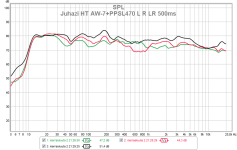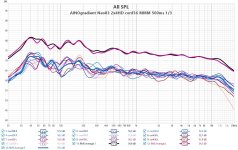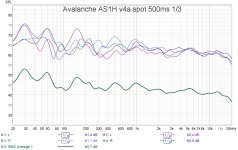Closed active 15" with Hypex FA dsp-plate amp would be my choice, small box and go very low in-room with good impact. SB Nero should be ok for that too, but huge number of good drivers. Even two boxes for same amp, to manage room modes. Reflex/TL/horn could be acceptable for PA use...
https://www.hypex.nl/products/amplifier-families/fusion-amplifier-family/
https://www.hypex.nl/products/amplifier-families/fusion-amplifier-family/
That statement makes perfect sense, thank you. 👍An inverse tapered (ML)TQWT is normally smaller with superior overall performance than a BR with an Av = Sd vent of the same tuning
Now can someone, anyone, please show me what a good example of such a design for a 15" woofer.
Hi Juhazi, the numbers for that driver don't look good for sealed. F3 at 70 Hz for 0.7 Q etc. And I don't want to chew up headroom with heavy EQ. I know you say lots of good drivers... But availability & price are not so easy everywhere. Feel free to suggest other similar priced 15" drivers from Solen that can work well closed without high EQ boost.
I'm keen to try this driver. I think Joseph Crowe found a gem for me: not only high performance but easy to get from within Canada at a relatively modest price. Note: big subwoofer drivers are heavy (Nero is 18kg) and not cheap to ship even within Canada.
Once it's in hand, I can try the woofer in a sealed 2' box I use for testing. The sealed + Linkwitz transform won't work for my son, but it might work for me.
I'm keen to try this driver. I think Joseph Crowe found a gem for me: not only high performance but easy to get from within Canada at a relatively modest price. Note: big subwoofer drivers are heavy (Nero is 18kg) and not cheap to ship even within Canada.
Once it's in hand, I can try the woofer in a sealed 2' box I use for testing. The sealed + Linkwitz transform won't work for my son, but it might work for me.
Data in your link says Fs is 31hz, and driver weight 16,3kg...
I'm not good with T/S and low end sims, but at least Nero can take huge wattage and has high Xmax. Power is cheap.... and don't forget room gain.
The cheaper Rosso is worse as sealed...

I'm not good with T/S and low end sims, but at least Nero can take huge wattage and has high Xmax. Power is cheap.... and don't forget room gain.
The cheaper Rosso is worse as sealed...
Last edited:
Here's SBA's Nero 15sw800 page -- https://www.sbaudience.com/index.php/products/subwoofers/nero-15sw800/ 18kg gross weight = 40 lbs. It'll be a beast to simply move into place to mount as I mostly work alone.Data in your link says Fs is 31hz, and driver weight 16,3kg...
Tried several box calculators -- most agree about 1.5 cubic foot for sealed Qts 0.7, Fb & F3=63/65Hz. F10=38Hz. Bass level doesn't catch up to 4' 28Hz port box till around 15Hz. Admittedly, box sizes are dramatically different: 44 vs 99 liters, so PEQ'd closed box is worth checking out.
I think your observation is a good one. If we work with a sealed driver in an enclosure with Vb=100litres and add a Linkwitz Transform as the EQ method, we can get a response similar to the one shown below. It has a relatively desirable second-order roll-off rate below the cut-off frequency of F3=31.3Hz. Approximately 8dB of boost has been added at 20Hz, which is quite a lot of extra power.... the numbers for that driver don't look good for sealed. F3 at 70 Hz for 0.7 Q etc. And I don't want to chew up headroom with heavy EQ.
If the size of the sealed enclosure is reduced to Vb=60litres, the Linkwitz Transform can be modified a little to obtain the following response.
Now, if we add a little bit of judiciously positioned PEQ (parametric EQ), we can achieve the following result. Here, F3 has been reduced from 31.7Hz down to 25.2Hz, but at the expense of 2dB drop in maximum output level.
Last edited:
your soundstage will collapse from the monopole bass which was most likely mixed in stereo. Vocals, kick and bass will be locked in the center.
Do we expect this to be a concern for the proposed use in a home environment
near nightclub levels of modern electronic music
Below 300Hz room modes modify room response and lowest mode has unbelievable effect. Below it pressurization may happen. I use dsp to eq speakers/room. Nearfield measurements show typical for sealed low bass roll-off. Woofer amps are just 100-200W and I never have to use full power, disco levels... Sealed woofers compresses in a smallish box, impossible to damage them (except long term burning that might happen with tests or war/space movie rumbles).
My 2,5x4m HT room has 15" mono sub (two Dayton DS15" sealed in a slot) Distortion at high spl comes from the furniture, so not shown here.

Living room is 4x6m open concept and just two 10" SEAS 26LROY sealed as stereo

Bedroom is 3x5m and has two sealed 8" woofers per side

My 2,5x4m HT room has 15" mono sub (two Dayton DS15" sealed in a slot) Distortion at high spl comes from the furniture, so not shown here.

Living room is 4x6m open concept and just two 10" SEAS 26LROY sealed as stereo

Bedroom is 3x5m and has two sealed 8" woofers per side

Why this still comes up? What's the point of Linkwitz Transform if you can EQ the response to the actual room, taste or whatever you want?add a Linkwitz Transform
It's just another type of EQ that seems quite well suited to a closed-box frequency response function over a broad frequency range. It's not something that has to be used.
But if the speaker is placed in a reflective environment, the low-frequency alignment (which is based on anechoic data or just derived from T/S parameters or achieved with Linkwitz Transform etc.) that looks good on paper goes to the trash.
Last edited:
But couldn't the same be said about the entire response of a loudspeaker system once it is placed in a reflective environment?
Yes, of course the same can be said about them. But applying Linkwitz Transform actually means EQing, and if you need to EQ to the room/target anyway, then the Linkwitz Transform can be completely omitted. So the question remains, what is the practical point of the Linkwitz Transform with the current EQ techniques? I don't think it makes sense anymore, other than posting pretty (and typically useless) graphs on forums.
Last edited:
There was a question about potentially using a Linkwitz Transform, and I thought I'd try and demonstrate its potential application. I was somewhat curious as to how it might work for this driver with a lowish Qts, and didn't intend to imply that it was the bee's knees when it came to creating worthwhile low-frequency alignments. The results that I plotted do show some of its disadvantages, as well as its benefits. Hopefully the plots were a little helpful, even without the superposition of room mode effects.
The LT is a kind of shelf filter. The negative aspect is that it tries to boost everything below Fs, including infrasonic rumble - even DC offset and that is something to avoid.
Think of a woofer playing 10Hz turntable rumble with enormous excursion and simultaneously trying to reproduce kickdrum loud kick or movie earthquake... A peak correction around 30Hz is what I use with dsp to boost low end. Notice the high Q neg. peak at 55Hz too. My TT preamp has subsonic filter, so it's not needed for speakers.

Think of a woofer playing 10Hz turntable rumble with enormous excursion and simultaneously trying to reproduce kickdrum loud kick or movie earthquake... A peak correction around 30Hz is what I use with dsp to boost low end. Notice the high Q neg. peak at 55Hz too. My TT preamp has subsonic filter, so it's not needed for speakers.
Ordered two SBA Nero 15sw800 today. $140 UPS shipping -- each carton is 46 lbs and apparently very large. No way to hide these from the missus. 😂
@Juhazi -- Thank your for the links in your recent post elsewhere.
In particular, https://www.rmsacoustics.nl/papers/whitepaperdistortion.pdf -- which led me to the RMS Acoustics web site, full of learned white papers on aspects of acoustic reproduction, including the provocatively titled, Why Bassreflex is not Suitable for Low-Frequency Musical Sound Reproduction. This is about the most precise analysis of bass reflex as it pertains to subwoofers that I've read, and yes, it's impossible not to agree with the title. Even reading only the conclusions page is convincing. Admittedly, I skimmed quickly over all the math. 😉
All this is relevant to my subwoofer project, which is the first in decades where I'm considering a ported design. All these years' I've perceived (heard) ported as inferior to sealed, old school transmission line, or good OB and the paper above has pushed me firmly back to that position.
Witwald's last post & simulation of a sealed 60 liter box with EQ is looking really attractive. This size box will be my first. Sketching some idea now of a very well braced 60 liter box. In a domestic setting.2.5 cubic ft is way better than 4.5.
The image below shows my thinking. It's a 14.5' box posted on Techtalks at PartsExpress. I'd add one more internal brace panel parallel to the front/back panel. External size -- near 70 liters. With all the bracing, I'll go to 15mm BB ply instead of my usual18mm or bigger. That will save ~20% weight. With driver at 40 lbs, a bit of weight savings in the box would help my back! Maybe 18mm for the front panel + 15mm (instead of rebating a thicker panel for the driver). Or forget the rebate and use 24mm?

In particular, https://www.rmsacoustics.nl/papers/whitepaperdistortion.pdf -- which led me to the RMS Acoustics web site, full of learned white papers on aspects of acoustic reproduction, including the provocatively titled, Why Bassreflex is not Suitable for Low-Frequency Musical Sound Reproduction. This is about the most precise analysis of bass reflex as it pertains to subwoofers that I've read, and yes, it's impossible not to agree with the title. Even reading only the conclusions page is convincing. Admittedly, I skimmed quickly over all the math. 😉
All this is relevant to my subwoofer project, which is the first in decades where I'm considering a ported design. All these years' I've perceived (heard) ported as inferior to sealed, old school transmission line, or good OB and the paper above has pushed me firmly back to that position.
Witwald's last post & simulation of a sealed 60 liter box with EQ is looking really attractive. This size box will be my first. Sketching some idea now of a very well braced 60 liter box. In a domestic setting.2.5 cubic ft is way better than 4.5.
The image below shows my thinking. It's a 14.5' box posted on Techtalks at PartsExpress. I'd add one more internal brace panel parallel to the front/back panel. External size -- near 70 liters. With all the bracing, I'll go to 15mm BB ply instead of my usual18mm or bigger. That will save ~20% weight. With driver at 40 lbs, a bit of weight savings in the box would help my back! Maybe 18mm for the front panel + 15mm (instead of rebating a thicker panel for the driver). Or forget the rebate and use 24mm?
Last edited:
THX, I read (and saved) that Grimm Acoustics paper about bass reflex first two years ago. I don't understand maths of that level but I love to look at pictures (of step response in this case. He promotes motional feedback (MFB, servo control) of which an example here https://data-bass.com/systems/5ad778f92d279a0004669a18
SVS is wise enough to offer sealed and BR subwoofers, their new 17" got good reviews like all earlier models too.
https://www.audioholics.com/subwoofer-reviews/svs-17-ultra-r-evolution-subwoofer
https://www.audioholics.com/subwoofer-reviews/svs-sb16-ultra
More about that bass https://data-bass.com/#/?_k=uzkf08
"Tapped Horn - If you are a financially strapped individual with a decent bass driver, it might make sense for you to attempt something like a large horn because it really can force multiply a driver's abilities. However there are some trade offs, most notably of which seems to be limited upper bandwidth, potentially rougher response shape and possible issues with ringing. Other challenges are the design / build complexity and the sheer size.
Bass Reflex - It is easy to see why bass-reflex designs are so prevalent as they get more out of a single driver over a large bandwidth. They can be made reasonable in size and don't have major issues, other than increased energy delay and decay near tuningand issues with port resonance, noise and compression.
Sealed Systems - Sealed systems are simple to design and build, are relatively forgiving of variations or mistakes and are more idiot-proof from damage in many cases. They also have no major acoustic issues related to the alignment itself to contend with, other than the fact that they do not offer the same amount of headroom and sensitivity over the intended bandwidth, driver for driver. However with enough drivers and power, the headroom can be increased as much as needed if the funds are there."
SVS is wise enough to offer sealed and BR subwoofers, their new 17" got good reviews like all earlier models too.
https://www.audioholics.com/subwoofer-reviews/svs-17-ultra-r-evolution-subwoofer
https://www.audioholics.com/subwoofer-reviews/svs-sb16-ultra
More about that bass https://data-bass.com/#/?_k=uzkf08
"Tapped Horn - If you are a financially strapped individual with a decent bass driver, it might make sense for you to attempt something like a large horn because it really can force multiply a driver's abilities. However there are some trade offs, most notably of which seems to be limited upper bandwidth, potentially rougher response shape and possible issues with ringing. Other challenges are the design / build complexity and the sheer size.
Bass Reflex - It is easy to see why bass-reflex designs are so prevalent as they get more out of a single driver over a large bandwidth. They can be made reasonable in size and don't have major issues, other than increased energy delay and decay near tuningand issues with port resonance, noise and compression.
Sealed Systems - Sealed systems are simple to design and build, are relatively forgiving of variations or mistakes and are more idiot-proof from damage in many cases. They also have no major acoustic issues related to the alignment itself to contend with, other than the fact that they do not offer the same amount of headroom and sensitivity over the intended bandwidth, driver for driver. However with enough drivers and power, the headroom can be increased as much as needed if the funds are there."
Last edited:
@witwald -- in case I didn't already, thanks very much for your helpful posts, especially the last one about a 60 liter sealed box!
Could you look at what happens in an even smaller sealed box, say 40 liters? Without the Linkwitz Transform, perhaps, just some judicious PEQ? Can it be made to go as low, say 25 Hz, and still put out at least 100dB at Xmax at that frequency?
The Nero 15sw800s are here & I'm itching to build cabs for them.
Could you look at what happens in an even smaller sealed box, say 40 liters? Without the Linkwitz Transform, perhaps, just some judicious PEQ? Can it be made to go as low, say 25 Hz, and still put out at least 100dB at Xmax at that frequency?
The Nero 15sw800s are here & I'm itching to build cabs for them.
- Home
- Loudspeakers
- Subwoofers
- Help with 15" SB Audience sub project